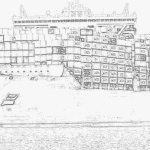“The present is only ever understandable through the past, with which it forms a living continuity; and the past is always grasped from our own partial viewpoint within the present. The event of understanding comes about when our own ‘horizon’ of historical meanings and assumptions ‘fuses’ with the ‘horizon’ within which the work itself is placed.”
-[Gadamer, (page 62, Eagleton)]
Hermeneutics scintillated a theory of interpretation, an exegesis on understanding the meaning of all texts written, specifically ancient scriptures. For understanding is the way of human existence or ‘Dasein’ like Heidegger puts it; understanding the past is a desideratum. Hermeneutics entered as a branch of knowledge of interpretation with Friedrich Schleiermacher, a German Theologian in 1819. He formed the skeleton for “general hermeneutics” as “the art of understanding” (page 127, Abrahams) the written texts.
Hermeneutics, “the art of understanding”: how can a literary text be understood or interpreted by the reader? Between the text and the reader dwells a stretch of ‘liminal’ space that conjoins the two. This space is capricious and needs an ally like Hermes ( the messenger god in Greek mythology who aid in the grasp of unintelligibility) to maneuver the reader all through the ‘limen’, the no man’s land. The theory of hermeneutics is such an ally to us in understanding a text. The hermeneutics pertain to all the works of the past, “all interpretation of a past work consists of a dialogue between past and present” (page 62 Eagelton) and the dialogue happening in the space between a distant past and the recent present characterized by a vast range disparate hypothesis, predilections, temperaments of a generation of an epoch. This reception tendency is ‘hermeneutics of reception’. A text when written, meanders away from the author like the Pappus of a dandelion and floats in a ‘diachronic career’ of time. So, hermeneutics evolves into a dual philosophy of time and interpretation. The diachronic career of time in ‘distanciation’ contract an exceeding configuration of meaning it had in all times; this exceeding meaning is a surplus of meaning acquired from the text, says Paul Ricoeur.
E. D. Hirsch Jr, an American hermeneutist showed a resistance to such an openness of meaning, he announces that, the meaning of a valid text is Autogenic and the ‘system of typical expectations and probabilities’ must gratify the author’s meaning. To him, “literary meaning is absolute and immutable, wholly resistant to historical change” (page 58, Eagleton). He asserts that the authorial meaning is fixed, and the meanings incurred in different ages are its significance. The meaning imparted by the author in his book is to be ‘recovered’ in metronomic regularity forsaking the ‘Surplus of meaning’ it ‘received’ through the ages.
But hermeneutics of reception is not the ‘recovery of the text, but how a text is ‘received’. We as a reader do not possess a parapsychological ability to have a divinatory re-experience of the text, as it was in the past. We can receive the text through the agency of surplus of meaning and reception history, but cannot ‘reconstruct’ or ‘recover’ the past, when the book was written through a divine extra sensory perception is in the past.
Hirsch’s idea of reconstruction of the author’s meaning is intimately linked to the divinatory re-experience of the original meaning that haunted the author which is fundamentally impossible. He would also be ‘prejudiced’ by the preponderance of his culture and is also intimidated by the relativism of ‘hermeneutics of reception’, but hermeneutics are correlated to ‘unfolding of meaning’ and no change of meaning (relativism). The very notion of ‘fixed meaning’ of Hirsch refers to the prominent nodes of ‘closed meaning’. He experiences time in linearity, but time is continuous cannot be stagnated.
“Time present and time past Are both perhaps present in time future, And time future contained in time past.” [Eliot, “Burnt Norton”, Four Quartets (1936)]
Time flows like a spill of liquid on the floor, which flows in all directions but predominantly in one direction. If time is continuous, then, why cannot the Godly re-experience of an object of the past is possible? The hermeneutics of reception makes possible the impossibility of experiencing the past by means of a Byzantine reception of counter-intuition. What do I mean when I say, hermeneutics of reception is counterintuitive? “Memory is never a precise duplicate of the original… it is a continuing act of creation. Dream images are the product of that creation,” says, Salvador Dali.
“We know that time has an impact on memory, but it is also memory that creates and shapes our experience of time. Our perception of the past molds our experience of time in the present to a greater degree than we might realize. It is memory that creates the peculiar, elastic properties of time. It not only gives us the ability to conjure up a past experience at will, but to reflect on those thoughts through autonoetic consciousness — the sense that we have of ourselves as existing across time — allowing us to re-experience a situation mentally and to step outside those memories to consider their accuracy.” [Hammond, “Time Warped”]
<http://www.brainpickings.org/index.php/2013/07/15/time-warped-claudia-hammond/>
The Experience of time past depends on feasibility of time; nostalgia is a distinct example experiencing the past. Controlling time is quite practicable, “why at our time slows down when we are afraid and gears up as we age?” concurrently, we cannot stop the time and teleport or levitate ourselves to a different time in the future to escape the brunt of fear. Similarly, nostalgia (‘the reminiscence bump’) is the way an agency of ‘reliving’ the past and not returning to the past. Hammond’s pronouncement is the ground for how time can be juggled and re-experienced.
Ergo, fixation of meaning is an illusion for we experience the past in terms of the present. There is nothing called original meaning to be rear guarded. When a text is written it becomes a content of ‘enfolded meaning’, which ‘unfolded’ cumulatively in a series of acts of reception in the future. Hence, for a hermeneutics of reception, the meaning of the past is always ‘open’ and ‘incomplete’ as opposed to ‘closed, meaning, which denotes ownership and restricts the others whereas, ‘open meaning’ invites participation of the others.
This theory of interpretation of the past has instigated the emergence of a club of discordant philosophers and amidst them Han Georg Gadamer and Paul Ricoeur are august philosophers. Hans Georg Gadamer, student of Martin Heidegger, whose existential philosophy of ‘Dasein’ ‘incorporated the act of interpretation’ based his theory on his master’s philosophy. His contribution to the theory of hermeneutics reception rests in his book Truth and Method (1960), this book made hermeneutics into a philosophy of ‘Verstehen’ or ‘understanding’.
The opening quotes of this paper, adumbrates Gadamer’s perception of ‘hermeneutics of reception’. Our understanding of the past is under the aegis of the present and the ‘understanding’ happens in the ‘horizon’ in which we are situated. ‘Horizon’ is a common metaphor for any generation. We all belong to our own respective ‘horizon’. And ‘horizon’ which we belong predisposes us to a ‘fore-having’ in consciousness. This fore-having or the background conceptualization in understanding or interpreting the given is what Gadamer calls ‘prejudice’.’Prejudice’ is the proclivity we have towards our own ‘horizon’.
“Prejudice is a positive rather than a negative factor: it was the Enlightenment, with its dream wholly disinterested knowledge, which led to the modern ‘prejudice against prejudice”
[Gadamer (page 62, Eagleton)
Gadamer is not inimical to ‘prejudice’ he invites it as creative prejudices adds to the surplus of meanings. But, he is against the ‘tyranny of prejudice’. To avoid the despotism and ‘naturalization’ of ‘prejudice’ one must step out of one’s ‘horizon’ and set forth to experience the ‘unfamiliar’ or ‘erfarung’.
The unfamiliar that we experience is the ‘effective history’. Time is present and, history is past; so, time is the consequence of the past. And past is the consequence of the present. The history in the interim of the past and the present is the ‘effective history’. Effective history is the philosophy of the journey of meaning in time. The space between the past and the present is an inexhaustible ‘chain of consequentiality’ in which the past continues. The present is the recent meaning of the past. This space is bridged by the ‘effective history’. In living the present; ‘we stand still in the effective history’. The ‘horizon’ and ‘the effective history’ are polar opposites, is it possible to converge them to make them meet? Can we add them both arithmetically? Like 1 + 1= 2, or should we neglect the trivial amongst the two and angle ourselves to our own, penchant? Gadamerian ‘Hermeneutics of reception does not allow biased insights. We can neither be pigeon holed in our ‘horizon’ nor be shoehorned into effective history. Following extremities are prohibited! Gadamer’s theorized stratagem to overcome this doubleness is ‘fusion of horizons’, which is experiencing both at the interception in equilibrium. Gadamer has mischievously, hidden the answer in his term for Prejudice, ‘horizon’: the place where the sky seems to meet the land of the sea, it intersection of two far away entities. German word, ‘Spiel’ meaning ‘play’ a monosyllabic expression, is the junction of predisposition of the horizon and the surplus of ‘unfolding meaning’; here we are the players who participate in the unfolding of meaning and play is the subject, the effective history. ‘Darstellung’ another Deustch word synonymous to ‘play’, meaning ‘presentation’ of ourselves in the ‘play’ of the ‘effective history’. It is in this intersection of the luminal space can a reader find the hidden work of art which requires ‘Alietheia’, ‘unconcealment’ to infer the enfolded meaning, we need to unshroud the clandestine, existence of meaning acquired by a work of art from the birth to the its journey of never ending future. After Gadamer, the hermeneutics of reception theory became a philosophy knowing and ‘understanding’ the ‘being’.
We, the human beings understand our existence at the ‘fusion of horizons’, “At such a moment we enter the alien world of the artefact, but at the same time gather it into our own realm, reaching a more complete understanding of ourselves .Rather than ‘leaving home’, Gadamer remarks, we ‘come home’”, because we have nothing to lose in the ‘effective history’ for “beneath all history, silently spanning past, present and future, runs a unifying essence known as ‘tradition’.” This tradition is the “uberlieferung”, meaning ‘the handing over’ of “history forms an unbroken continuum, free of decisive rupture, conflict and contradiction” (page 63, Eagleton). A text may incur umpteen meanings in unbroken time, which can alter the meaning of the text but the historicity of the book in not mutated or deformed, rather it ‘deepens’ the pre-existing meaning in the text.
Gadamer says, “[our historical consciousness] is always filled with a variety of voices in which the echo of the past is heard. It is present only in the multifariousness of such voices: this constitutes the nature of tradition in which we want to share and have a part”
[‘Tradition and method’, 284]
These voices are ‘uberlieferung’, which annexes us on daily bases, we nullify the old to evolve into the semantic and traditional novelty.
To master the art of hermeneutic understanding, we must follow the process of ‘hermeneutic circle’, i.e., experiencing meaning literature an ‘organic whole’, “in order to understand the determinate meanings of the verbal parts of any linguistic whole, we must approach the parts with a prior sense of the meaning of the whole; yet we can know the meaning of the whole only by knowing the meanings of its constituent parts. [Page 148, MH Abrahams] the circle of hermeneutics is determined. Gadamer’s philosophy of effective history is a sophisticated philosophy which experiences time as “the intersection of the timeless moment.”
“The hermeneutics of reception” is often blamed for its anarchy, ignorance of the reader and saturation of ‘historicity’. So in the neoteric development, theorists are trying include more of a reader. As an answer “Hans Robert Jauss, goes on to say,
“The aim of this work is to produce a new kind of literary history – one centred not on authors, influences and literary trends, but on literature as defined and interpreted by its various moments of historical ‘reception’. It is not that literary works themselves remain constant, while interpretations of them change: texts and literary traditions are themselves actively altered according to the various historical ‘horizons’ within which they are received.” [Page 72, Eagleton]
The hermeneutics of reception not based on the readers or the author, it concern with the mystery of the space in between the contemporary of the author and the present. But all the new conceptions give vitality to the contemporary forgetting the whispers of our ancestors in the air of the time past. Later in the 20th century, emerges structuralism. But the hermeneutics of reception is an inevitably breakthrough in the field of interpretation.
Indian Review | Authors | Literature, Literary Criticism & Literary Theory | Ramya R presents a paper on hermeneutics of reception






Leave a Reply